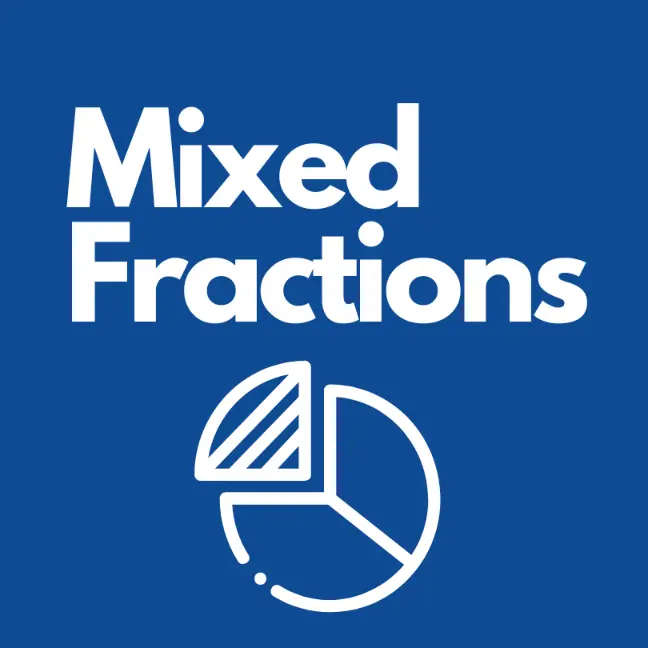Convert Mixed Number to Decimal
Enter a mixed number or fraction to convert to a decimal number
Related Mixed Fraction Calculators
See all maths calculators
Convert Mixed Number to Decimal Guide
Converting mixed numbers to decimals is a fundamental mathematical skill that finds applications in various fields, from everyday calculations to complex scientific analyses. This comprehensive guide will walk you through the process of converting mixed numbers to decimals, provide practical examples, and offer insights into common pitfalls and real-world applications.
Understanding Mixed Numbers
A mixed number is a combination of a whole number and a proper fraction. For instance, 3 1/2 is a mixed number where 3 is the whole number part and 1/2 is the fractional part. Mixed numbers are commonly encountered in everyday scenarios, such as in cooking measurements or when expressing quantities that aren't whole numbers.
The Conversion Process: From Mixed Numbers to Decimals
Converting a mixed number to a decimal involves two main steps:
Step 1: Convert the Fraction to a Decimal
First, we need to convert the fractional part of the mixed number into a decimal. This is done by dividing the numerator by the denominator.
For example, in the mixed number 3 1/2:
1 ÷ 2 = 0.5
Step 2: Add the Whole Number to the Decimal
Next, we simply add the whole number part to the decimal we obtained in step 1.
Continuing our example:
3 + 0.5 = 3.5
Therefore, 3 1/2 as a decimal is 3.5.
Examples of Mixed Number to Decimal Conversions
To better understand the process, let's look at a table of mixed number to decimal conversions:
| Mixed Number | Calculation | Decimal Form |
|---|---|---|
| 2 3/4 | 2 + (3 ÷ 4) | 2.75 |
| 1 1/3 | 1 + (1 ÷ 3) | 1.333... |
| 4 5/8 | 4 + (5 ÷ 8) | 4.625 |
| 0 7/10 | 0 + (7 ÷ 10) | 0.7 |
| 5 1/6 | 5 + (1 ÷ 6) | 5.166... |
| 3 11/12 | 3 + (11 ÷ 12) | 3.916... |
Alternative Method: Converting to Improper Fractions
An alternative method for converting mixed numbers to decimals involves first changing the mixed number to an improper fraction. Here's how it works:
- Multiply the whole number by the denominator of the fraction.
- Add this result to the numerator.
- Place this sum over the original denominator.
- Divide the numerator by the denominator to get the decimal.
Let's use this method to convert 2 3/5 to a decimal:
- 2 × 5 = 10
- 10 + 3 = 13
- 13/5
- 13 ÷ 5 = 2.6
This method can be particularly useful when dealing with complex fractions or when you prefer working with improper fractions.
Common Mistakes to Avoid
When converting mixed numbers to decimals, there are several common mistakes to be aware of:
-
Forgetting to add the whole number: Some people mistakenly convert only the fractional part to a decimal, forgetting to include the whole number.
-
Incorrect division: When dividing the numerator by the denominator, it's crucial to carry out the division accurately. Even small errors can lead to significant inaccuracies in the final result.
-
Mishandling recurring decimals: Some fractions result in recurring decimals (e.g., 1/3 = 0.333...). It's important to recognize these and represent them correctly, often using an overbar or ellipsis.
-
Rounding too early: For precise calculations, it's important to carry out the division to several decimal places before rounding.
Practical Applications
Understanding how to convert mixed numbers to decimals has numerous real-world applications:
Finance and Accounting
In financial calculations, decimals are often preferred over fractions. Being able to quickly convert between mixed numbers and decimals can be invaluable for financial analysis, budgeting, and accounting tasks.
Science and Engineering
Scientific and engineering calculations often require precise decimal representations. Converting mixed numbers to decimals is crucial for accurate measurements and calculations in these fields.
Cooking and Baking
While many recipes use fractions, converting these to decimals can be useful when scaling recipes or using digital kitchen scales that display weights in decimal form.
Construction and Carpentry
In construction and carpentry, measurements are often given in mixed numbers (e.g., 3 1/4 inches). Converting these to decimals can be helpful when using certain tools or performing calculations.
Using Technology: Mixed Number to Decimal Calculators
While it's important to understand the manual process, there are many online tools and calculators available that can quickly convert mixed numbers to decimals. These tools can be particularly useful for complex calculations or when dealing with large numbers.
When using such calculators, it's important to:
- Verify the input format required by the calculator.
- Double-check your entries for accuracy.
- Understand the level of precision offered by the calculator.
- Use the results judiciously, especially in professional or academic contexts where showing your work may be required.
The Importance of Understanding Decimals
Decimals are a fundamental concept in mathematics and are widely used in various aspects of daily life. They provide a precise way of expressing quantities and are essential for many types of calculations. By mastering the conversion of mixed numbers to decimals, you enhance your numerical literacy and problem-solving skills.
Working with Recurring Decimals
When converting mixed numbers to decimals, you may encounter recurring decimals. These are decimals where a digit or group of digits repeats indefinitely. For example:
1 1/3 = 1.333333...
In mathematical notation, this is often represented as 1.3̅ (with a bar over the 3) or 1.3(3) to indicate that the 3 repeats infinitely.
Understanding recurring decimals is important because:
- They represent exact values, not approximations.
- They can be converted back to fractions if needed.
- They're commonly encountered in many mathematical and real-world scenarios.
Conclusion
Converting mixed numbers to decimals is a valuable skill that bridges different ways of expressing quantities. Whether you're a student, a professional, or simply someone who enjoys working with numbers, understanding this process can enhance your mathematical capabilities and practical problem-solving skills.
Remember, practice is key to mastering this conversion process. Start with simple mixed numbers and gradually work your way up to more complex ones. With time and practice, you'll find that converting mixed numbers to decimals becomes second nature.
Key Takeaways
- A mixed number consists of a whole number and a proper fraction.
- To convert a mixed number to a decimal, convert the fraction to a decimal and add it to the whole number.
- An alternative method involves converting the mixed number to an improper fraction first.
- Common mistakes include forgetting to add the whole number and incorrect division.
- This skill has practical applications in finance, science, cooking, and construction.
- While calculators are available, understanding the manual process is crucial for developing mathematical intuition.
- Be aware of recurring decimals and how to represent them accurately.
By mastering the conversion of mixed numbers to decimals, you'll have a powerful tool at your disposal for various real-world calculations and analyses.

